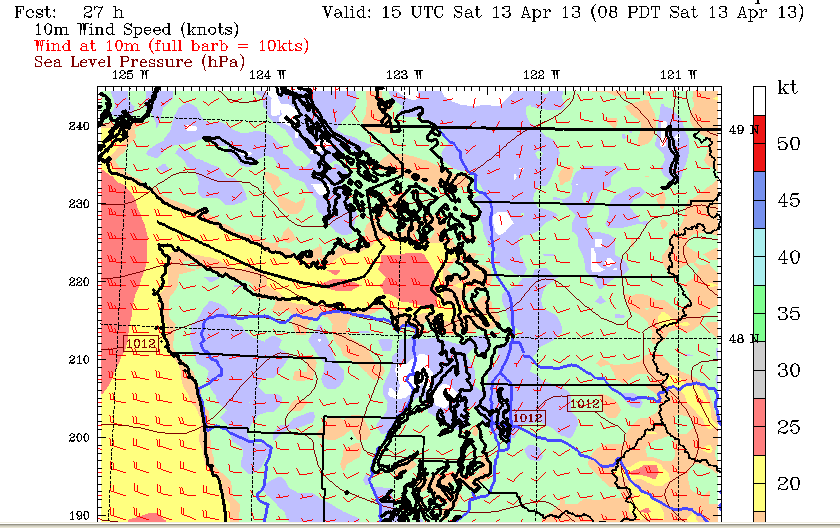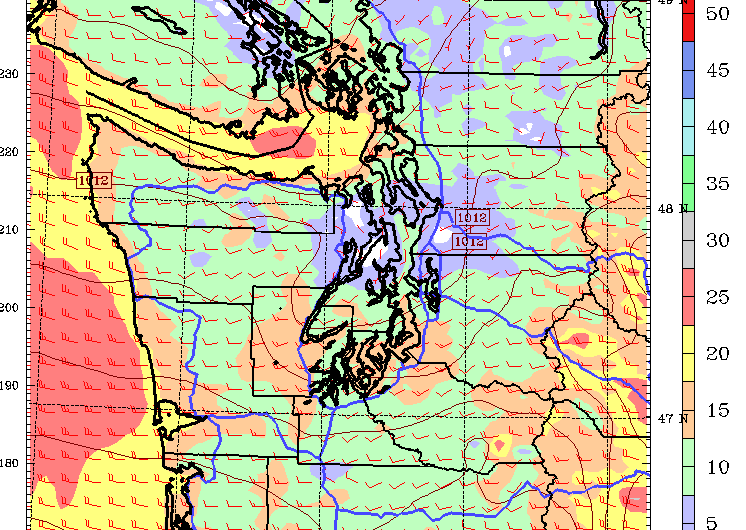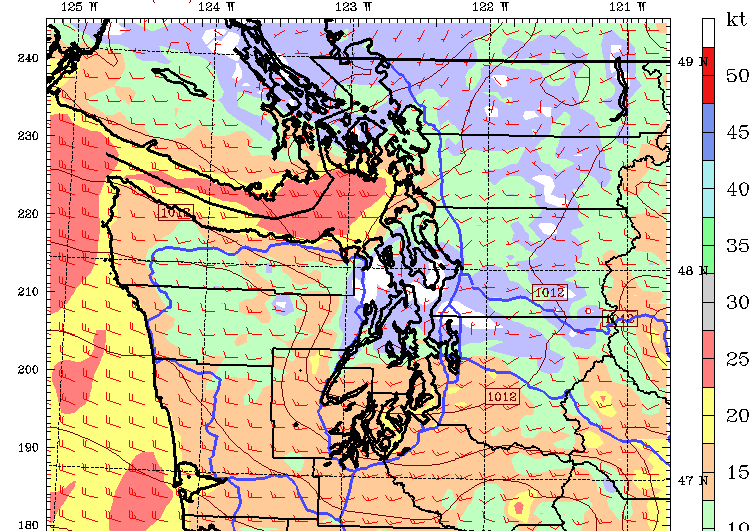Sloop Tavern Blakely Rock Benefit Regatta
Absolutely one of our favorite regattas and one we don’t miss. Since it’s always held for a great cause I think the wind gods tend to smile on this event more often than not. This year the proceeds from the BRBR go to Sail Sand Point so go to the Sloop and spend some money and help this great organization out.
Tides, Wind, and Tactics
The wind will almost certainly be from the south-southwest at the start in a classic post frontal situation. As you can see from the Surface Forecast Chart, the front will have moved on to Montana leaving us with an onshore flow of cool and unstable air. With the low centered off the north end of Vancouver Island the flow will be from the northwest which will create an interesting situation as the day moves on.
The race will start at 1100 hrs which means that with the reverse start, the small boats and NFS boats will start first and just after max ebb which is at 1011 hrs and measuring .9 knot at West Point. Considering the amount of rain we will have had over the last 24 hours and the fact that it has been blowing from the south for the last 48 hours averaging probably 8-12 knots expect the ebb to be running harder than that by .2 to .3 knot and lasting as much as 30-45 minutes past the advertised slack at 1356 hrs. This will dictate that after the start it will be the classic beat feet up the Shilshole Breakwater in what should be a very localized south-southeasterly. If you get forced out of the starboard tack parade to the beach, hitch to port just long enough to find a clear lane back into the beach. Avoid the restricted zone delineated by the Sailing Instructions and don’t come back into the beach sailing on starboard directly into the outfall from the Ship Canal. Work your way under West Point and remember that sand bar at West Point now has a shallow bump north of the line from the lighthouse to the West Point Buoy and remember that it is a falling tide so parking in the sand can be very expensive when it comes to time lost. The safe way to cross the shallow spot, depending upon the draft of your vessel, is to be about ½ way to ¾ of the way off the beach to the buoy. Then don’t hitch back into Elliott Bay once you clear the Point because the tide ebbs harder along that shore because of the outfall from the Duwamish with the freshwater staying on top of the saltwater and there being a wind driven surface current.
From West Point hold on port tack and get to the Bainbridge shore. Remember also that with the reverse start you’ll be sailing into the slower boats which means you really have to focus on keeping your air clear. If you find yourself sailing slower than targets or sailing inexplicably lower than your fleet, you may be in dirty air. You’ll be progressively headed as you go across the Sound. Get far enough across to get out of the major part of the ebb before you hitch back to starboard and go towards the Rock. If you can, take advantage of the ebb out of Eagle Harbor which flows to the SSE almost ½ way to Blakely Rock.
It’s going to be the leg from Blakely Rock back to Meadow Point that will be interesting. As you can see from the 1100 hour chart (above) the onshore flow will be coming down Straits and around the bottom end of the Olympics, accelerating as flows through the Chehalis Gap and heads up the Sound. At some point however the flow down the Straits is going to win out and that’s going to produce a northerly.
This will mean that you’re really going to have to keep your head out of the boat and watch for that low dark cloud moving down from the north.
Since the leeward mark, Meadow Point, will now become the windward mark you are not going to want to stray too far from the rhumb line course as when that northerly does fill down, it can be fairly shifty. The rhumb line will keep you close to West Point and the ebb will keep you out in the tide on starboard tack as you clear West Point until you can tack to port and end up aiming roughly for the Ballard Blinker Buoy.
The other point to remember is that when the northerly first fills down, that is usually the strongest breeze you will see and it will drop from there. So if you can hang in there with your number one by moving the lead aft and outboard, flattening and twisting off the main and hike, hike, hike, the one will be the sail you’ll need to finish. You’ll also want to make sure you’re set up for a bear away, port pole, set at Meadow Point as the local effect will probably have the breeze from the north-northeast and that should give you a straight run to the finish.
Before you leave the house you’ll want to check the weather at West Point for wind direction, and wind strength and the trend in the barometer which should be rising like crazy. Next you’ll want to check Washington State Ferry weather on the Bainbridge Island and Edmonds-Kingston run. When you get to the boat, crank up the VHF to KHB-60 NOAA Weather radio and log the pressure readings for Forks, Bellingham, Seattle, Portland, Astoria,. North Bend, and Wenatchee. Those get updated every three hours and it will help you get a feel for when the northerly will fill down the Sound.
Predictions!
My favorite part! This year the weather and tides will favor the biggest and fastest boats in your fleet with a couple of exceptions.
Class 1 NFS, I like the two Catalina 30’s with their sail carrying ability however if there’s a light, shifty changeover watch out for the Antsea and Blue Lullaby.
Class 2 NFS Pretty much a no brainer as that crafty veteran, Bill Pirrie, with his beautiful Islander 36 Whistling Swan always seems to have this race totally dialed.
Class 3 NFS Another no brainer as not only is the biggest boat the fastest boat it is also very well sailed and that would be Jim Marta’s Eye Candy who will stretch out on the beat south to Blakely Rock and may finish well ahead of the northerly.
Class 4 Flying Sails. This could be a great battle between Deception, Smola and Backslider.
Class 5 FS. The rating spread in this class is relatively close (only 16 seconds) compared to the other classes so this will come down to whoever gets the best start, makes the fewest mistakes in a boat and sail handling. Could be Shogun, Blue Jeans or Scotch& Soda.
Class 6 FS. Another no brainer as Tim Morgenroth with his tall rigged Baba 40 Airloom will win this Class for the 42nd year in a row.
Class 7 FS. Easily the toughest class out there populated exclusively with high performance, light weight boats. Totally up for grabs but you have to like Three Ring Circus, More Uff Da, More Cowbell, Little Blue Dune Buggy and maybe even the rarely seen Norn.
Class 8 FS. Just because these guys are out there racing all the time and have been for years Rubicon and Kowloon are going to be the ones to beat.
Class 9 FS. Could this be THE Roy Rard who is sailing Rachel? I digress; look for Scimitar to have another close race with Beer and How.
Class 10 FS. If the breeze hangs in there for the run, the Melges 24 will be tough, as it shifts to lighter air watch for the J-105’s, and if it gets to say less than 8-knots and stays that way, the Soverel 33 Pegasus could be tough.
Class 11 FS. The exception to the bigger-faster-boat-will-win rule as the smallest and theoretically slowest boat, he Sierra 26 DOS will almost certainly dominate this class and will probably be the first boat to finish as well.
Class 12 FS. Another really tough class with a very narrow rating band of only three seconds however if the breeze is up for the beat and then drops on the run look for Bravo Zulu to win this one.
Class 13 FS. The big boat class and another case of the smallest boat, the Riptide 35 Terremoto, looks pretty ideally suited to these conditions.
Class 14 Multihulls. Freda Mae has had a great year and there is no reason to think that this will change.
Good luck, see you out there!






3 comments
Most excellent article Bruce.
Cant wait to see the recap.
Bruce has promised a recap from his front row seat on Tahlequah, which was second in class. He’s currently putting the May issue of Northwest Yachting Magazine to bed but he’ll find a few minutes sometime soon. –KH